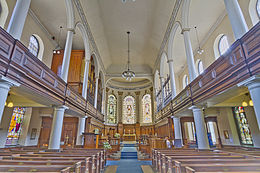St Ann's Church, Manchester
| St Ann's Church, Manchester | |
|---|---|
 |
|
| Denomination | Church of England |
| Churchmanship | Broad Church |
| History | |
| Dedication | St Anne |
| Administration | |
| Parish | St Ann's |
| Archdeaconry | Manchester |
| Diocese | Manchester |
| Province | York |
St Ann's Church in Manchester, England was consecrated in 1712. Although named after St Anne, it also pays tribute to the patron of the church, Ann, Lady Bland. St Ann's Church is a Grade I listed building.
At the beginning of the 18th century, Manchester was a small rural town little more than a village, with many fields and timber-framed houses. A large cornfield named Acres Field, which is now St Ann's Square, became the site for St Ann's Church.
The church was an impressive building and although it stood between the market and the collegiate church, both towers could be seen from all directions. It is a neo-classical building, originally constructed from locally quarried, red Collyhurst sandstone although, due to its soft nature, much of the original stone has since been replaced with sandstone of various colours from Parbold in Lancashire, Hollington in Staffordshire, Darley Dale in Derbyshire and Runcorn in Cheshire. When the church was first constructed, the interior was extremely simple with plain glass windows. However, in the 19th century many changes were made, including the installation of stained glass windows. Some of these were bespoke and others were adapted from other churches. One such window, on the north side of the church, was designed and made by William Peckitt of York.
The tower of the church marks the centre of the city; surveyors used it as a platform to measure distances to other locations. Their benchmark remains visible at the tower door.
...
Wikipedia
